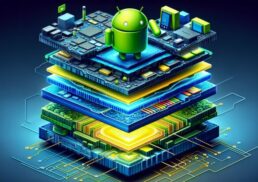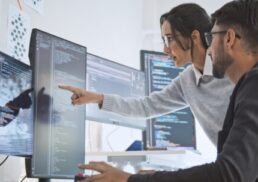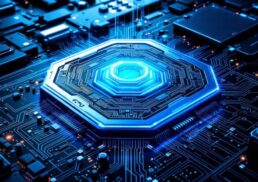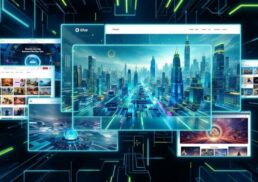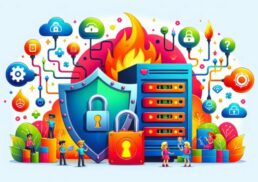A robotics operating system (ROS) is a framework that simplifies the development of robot software. It provides essential tools and libraries for building complex and efficient robotic systems. This article explores ROS’s main features, practical uses, and its evolution.
Table of Contents
Key Takeaways
The Robot Operating System (ROS) serves as a flexible and modular framework essential for developing complex and sophisticated robotic applications via hardware abstraction and distributed computing architecture.
Since its inception in 2007, ROS has evolved significantly with the introduction of ROS 2 in 2018, addressing performance, security, and real-time processing capabilities to meet modern robotics demands.
The ROS ecosystem, supported by a global community, offers extensive applications across various industries including autonomous vehicles, industrial robotics, and medical robotics, and provides abundant learning resources for developers at all skill levels.
Understanding Robotics Operating Systems

The foundational concept behind the creation of the Robot Operating System (ROS) was to establish a flexible and robust framework for the development of robotics software. Its design aims to provide a versatile platform for building and implementing robotic systems. This collection of tools and libraries assists developers in creating complex and robust robot applications. It provides them with the necessary resources to build sophisticated and reliable software for robots. ROS simplifies the process of building modular, distributed, and reusable code, making it an essential tool for robotics research and development.
A defining feature of ROS is its hardware abstraction capabilities, enabling developers to concentrate on developing high-level functionalities, while hardware interfaces specifics are handled seamlessly. This is particularly beneficial in a field where integrating various sensors, actuators, and other hardware components can be incredibly complex. By using ROS, developers can easily implement commonly used functionalities, such as message-passing and package management, which are crucial for building sophisticated robotic systems.
The design of ROS’s architecture is aimed at streamlining the development of advanced robotic applications. This allows them to avoid becoming caught up in low-level system integration complexities. This is achieved through a modular and distributed computing architecture, where nodes communicate with each other via topics, services, and actions. This structure not only simplifies the development process but also ensures that the system is highly scalable and adaptable to various robotic applications.
For educational purposes, ROS serves as a critical tool in imparting essential robotics concepts to students. Universities use ROS to experiment with different robotic systems, learn about its architecture, and gain practical experience through simulations and hands-on projects. This hands-on approach helps students grasp the intricacies of robotics in a standardized framework, preparing them for real-world applications.
Despite continuous advancements and an expanding ecosystem, ROS maintains its pivotal role in the development of advanced robotic applications. The primary platform for ROS is Ubuntu, which provides a stable and robust environment for developing and running ROS applications. With tools like RViz for visualization and Gazebo for simulation, ROS offers a comprehensive suite of resources to support every stage of the development process.
Evolution of ROS
The inception of ROS traces back to 2007 at Willow Garage, a robotics research lab that aimed to establish a standardized platform for robotics development. Initially developed to support the PR2 robot, ROS quickly gained traction in the robotics community as an open-source robotics stack. The first pieces of what eventually became ROS started coalescing at Stanford University, with the first commit of ROS code made to SourceForge on November 7, 2007.
The first official version of ROS, known as ROS 1, was released in 2009. This version laid the foundation for many subsequent developments and became widely adopted in academic and industrial settings. Companies like Rethink Robotics used ROS in their collaborative robots (cobots), showcasing its potential in real-world applications. The leadership of Open Robotics has been instrumental in steering the development of ROS, ensuring it meets the evolving needs of the robotics community.
Introduced in 2018, ROS 2 was designed to overcome the shortcomings of ROS 1, offering substantial enhancements in performance, security, and real-time capabilities. This new version was designed to meet the demands of modern robotics applications, providing a more robust and scalable framework. The introduction of ROS 2 marked a new era in the evolution of ROS, ensuring it remains at the forefront of robotics research and development.
ROS Architecture
ROS architecture is organized into three distinct layers:
The Filesystem Level, which includes the organization of packages, stacks, and other resources.
The Computation Graph Level, which encompasses nodes, the Master, Parameter Server, messages, services, topics, and bags, which together form the core of ROS’s functionality.
The Community Level, which involves the collaboration and sharing of resources among the ROS community, fostering a rich ecosystem of tools and libraries.
At the heart of the ROS architecture are:
Nodes: represent processes that perform computation tasks and communicate with each other using a publish/subscribe model
The ROS Master: acts as a centralized registry, telling nodes which other nodes they should connect to and in which way
The Parameter Server: stores and manages dynamic configuration data, ensuring consistency and easy access for all nodes in the network
Together, these components create a cohesive and efficient system for building advanced robotic applications.
ROS Nodes
Nodes are the building blocks of ROS, representing individual processes that perform specific computation tasks. Nodes typically handle specific functions, like controlling sensors, processing data, or running algorithms. This allows for efficient and specialized task management within the network. For example, a node might be responsible for controlling wheel motors, performing localization, or executing path planning algorithms. This modular approach allows developers to break down complex robotic applications into manageable, reusable components.
In the ROS ecosystem, nodes communicate with each other through topics, services, and actions. This communication is facilitated by the ROS Master, which ensures that nodes can find and connect with each other. By using nodes, developers can create distributed systems where different parts of the robot operate independently yet cohesively, enhancing the overall flexibility and scalability of the system.
Learn more, check out [ROS in 5 mins] 009 – How to Launch a ROS node.
ROS Master
The ROS Master is a crucial component that facilitates communication among nodes by acting as a centralized registry. It stores topics and services registration information, allowing nodes to find each other and establish direct connections for data exchange. The Master functions similarly to a DNS server, providing lookup information without being involved in the actual data transfer between nodes.
When running a ROS system, the roscore command is used to launch the core processes, including the ROS Master and the Parameter Server. The Parameter Server, which is part of the Master, allows nodes to store and retrieve configuration data in a central location. This centralized approach simplifies the management of dynamic configurations and ensures that all nodes have access to the necessary parameters for their operation.
Parameter Server
The Parameter Server in ROS is a shared, multi-variable dictionary accessible to all nodes in the ROS network. It stores global variables that nodes need to access and share, ensuring consistency and easier management of configuration parameters. Parameters can include configurations such as robot dimensions, sensor calibration values, and operational modes.
Nodes can:
Set, retrieve, and delete parameters from the Parameter Server, providing a structured way to manage data.
Subscribe to specific parameters, ensuring they always work with the most current data version.
Use dynamic reconfiguration capability for tasks such as initial setup of robot configurations and managing operational states.
This capability is particularly useful for managing data in a structured and efficient manner.
Writing Robot Software with ROS
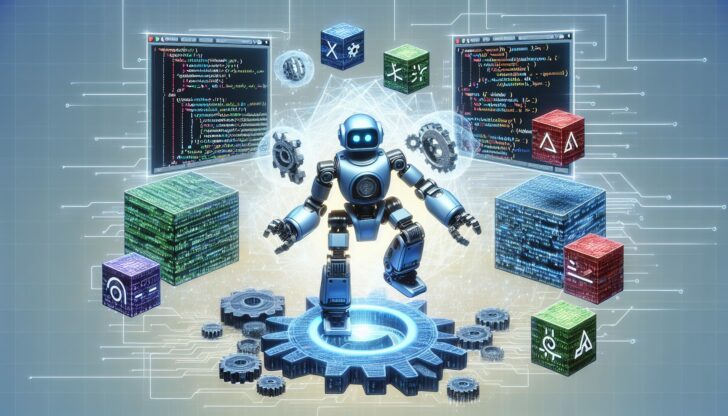
Developing robot software with ROS entails the creation of modular and reusable code, utilizing an assortment of software frameworks and tools. The first step in developing ROS applications is to create a package within the src folder of the workspace. A typical ROS package contains:
Nodes
Configuration files
Launch files
Other resources necessary for the application
This modularity reduces development time and effort by allowing reuse of existing code and enabling easy integration of new functionalities or hardware upgrades without disrupting the entire system’s operation.
The main programming languages for writing ROS code are C++ and Python. These languages provide robust libraries and tools that facilitate the development of complex robotic applications. The rosrun command is used to run nodes within a specified ROS package, streamlining the development and testing process.
Creating and managing ROS packages is a fundamental aspect of ROS development, enabling developers to organize and share code efficiently. The catkin_create_pkg command is used to create new ROS packages with specified dependencies, ensuring that all necessary components are included from the start.
Creating ROS Packages
Package creation forms a fundamental part of writing robot software with ROS. The catkin_create_pkg command is used to create a new ROS package with specified dependencies, ensuring that all necessary components are included from the start. A typical ROS package directory includes folders such as ‘src’ for source code, ‘scripts’ for Python scripts, and ‘launch’ for launch files. This structure helps in organizing the code and resources, making it easier to manage and share with other developers.
Once a package is created, it can be updated manually to add or modify dependencies. This flexibility allows developers to adapt their packages to new requirements or integrate additional functionalities as needed. By leveraging the package management system in ROS, developers can foster collaboration within the robotics community, contributing to a shared ecosystem of reusable code and tools.
Programming Languages for ROS
C++ and Python, commonly referred to as roscpp and rospy respectively, are the principal programming languages employed in ROS. These languages provide robust libraries and tools that facilitate the development of complex robotic applications. C++ is favored for its performance and efficiency, making it suitable for real-time and computationally intensive tasks. On the other hand, Python is appreciated for its simplicity and ease of use, which accelerates the development process and is ideal for scripting and prototyping.
ROS 2 integrates a base library written in C (rcl), allowing faster availability of core functionalities across different APIs. This integration ensures that developers can leverage the strengths of both C++ and Python, depending on their specific needs and the requirements of their robotic applications. By providing support for multiple programming languages, ROS enhances the flexibility and adaptability of the development process, making it accessible to a broader range of developers.
Launch Files
In ROS, launch files serve the purpose of:
Defining a set of nodes along with their interconnections
Facilitating the simultaneous start-up of multiple nodes and configurations
Automating the setup and execution of complex robotic systems
Ensuring that all necessary components are configured and running correctly
These files are written in XML format and can include arguments to customize the initialization of nodes. By using launch files, developers can automate the setup and execution of complex robotic systems, ensuring that all necessary components are configured and running correctly.
To run launch files in ROS, the roslaunch command is used. This command simplifies the process of starting multiple nodes and configurations, streamlining the development and testing workflow. Launch files are particularly useful for managing large-scale robotic applications, where numerous nodes need to be coordinated and executed in a specific order. By leveraging launch files, developers can enhance the efficiency and reliability of their ROS-based systems.
Integrating ROS with Robot Hardware
The integration of ROS with robot hardware forms a crucial step in the development of operational robotic systems. ROS provides a range of libraries and tools that assist developers in creating applications that integrate seamlessly with diverse types of robot hardware. This integration is facilitated through hardware abstraction, device drivers, and firmware, which together ensure efficient and reliable communication between software and hardware components.
One of the primary benefits of using ROS for hardware integration is the increased efficiency and cost-effectiveness it offers. By providing standardized interfaces and a strong community support, ROS enables developers to focus on high-level functionalities without worrying about the intricacies of hardware integration. This interoperability is crucial for developing versatile and scalable robotic applications.
Examples of hardware integration in ROS include controlling sensors, actuators, and other peripheral devices. ROS drivers provide access to the low-level functionality of hardware devices, allowing developers to read data, send commands, and configure parameters. Additionally, firmware in ROS can run on hardware devices like microcontrollers or single-board computers, enhancing the efficiency and robustness of the overall system.
Hardware Abstraction
In ROS, hardware abstraction streamlines the interaction between software and hardware elements in a robotic system. By providing standardized interfaces for different hardware components, ROS ensures that developers can work on higher-level functionalities without delving into the specifics of hardware interfaces. This abstraction layer allows for seamless integration of new hardware components and upgrades, enhancing the overall flexibility and scalability of the system.
Through hardware abstraction, ROS standardizes how drivers communicate with other components like nodes, topics, or actions, abstracting hardware details. This standardization not only simplifies the development process but also ensures consistency and reliability across different robotic applications. By using hardware abstraction, developers can focus on building advanced robotic functionalities without being bogged down by hardware-specific challenges.
Device Drivers
In ROS, device drivers play a crucial role in accessing and managing the low-level functionalities of different hardware devices. These drivers provide the necessary interfaces for reading data, sending commands, and configuring parameters, ensuring reliable communication between software and hardware components. The compatibility and performance of ROS drivers are critical for the overall reliability and efficiency of the robotic system.
The joy package is an example of a ROS driver. It offers generic drivers for joysticks and gamepads, among other functionalities. This package can be installed via a specific command, enabling developers to easily integrate these input devices into their robotic applications. By leveraging device drivers, developers can ensure that their ROS-based systems can interact seamlessly with a wide range of hardware components, enhancing the versatility and functionality of their robotic applications.
Key Applications of ROS
With its adaptability, ROS finds usage in a diverse range of robotic applications, right from industrial robots to domestic robots. Its flexibility, modularity, and rich set of tools have contributed to its extensive adoption across numerous industries, including agriculture, medical devices, and even household vacuum cleaners. As robotics technology continues to advance, ROS is expected to play a pivotal role in enabling the development of innovative and sophisticated robotic applications.
Key factors contributing to the extensive applications of ROS include its ability to integrate sensors, implement algorithms, control actuators, and manage overall functionality regardless of the application domain. This versatility makes ROS a fundamental tool in fields such as autonomous vehicles, industrial robotics, humanoid robots, medical robotics, agricultural robotics, UAVs, and service robotics. By leveraging ROS, developers can create advanced robotic systems that address the unique challenges and requirements of these diverse domains.
Autonomous Vehicles
Within the sphere of autonomous vehicles, ROS serves a vital function by facilitating the integration of sensor data, perception algorithms, and control systems. This integration allows autonomous vehicles to fuse data from various sensors, such as LIDAR, cameras, and GPS, to create a comprehensive understanding of their environment. ROS’s flexible architecture supports the development and testing of decision-making algorithms and control systems that allow autonomous vehicles to navigate and operate safely.
One notable example of ROS’s application in autonomous vehicles is its use in the DARPA Urban Challenge, where teams developed self-driving cars capable of:
Navigating urban environments autonomously
Leveraging ROS to integrate complex sensor data
Implementing sophisticated perception algorithms
Developing robust control systems
This success highlights the potential of ROS to drive innovation and advancements in autonomous vehicle technology.
Industrial Robots
ROS facilitates the design of industrial robots capable of performing a variety of tasks such as pick-and-place, assembly, and welding. It is a versatile platform that supports the development of a wide range of robotic applications. By coordinating robotic arm movements and integrating sensors for object detection, ROS enables precise and efficient execution of complex operations. This capability is particularly valuable in manufacturing automation, where precision and reliability are paramount.
One prominent example of ROS in industrial robotics is its use by Universal Robots, a leading manufacturer of industrial robotic arms. By leveraging ROS, Universal Robots can program and control their robotic arms to perform a wide range of tasks, from simple pick-and-place operations to complex assembly and welding processes. This integration enhances the flexibility and scalability of industrial robotic applications, enabling seamless interaction between different components of an industrial setup.
Medical and Service Robotics
Within medical robotics, ROS assists in the integration of imaging systems, precise robotic arm control, and haptic feedback for surgical assistance. The Raven II surgical robot, developed by the University of Washington, is a notable example of robotics research using ROS. It has been utilized in the study of teleoperated surgical robotics. By leveraging ROS, the Raven II can perform the following precise and controlled surgical tasks:
Incision and suturing
Tissue manipulation and retraction
Instrument manipulation and positioning
Tumor removal and biopsy
These capabilities enhance the abilities of surgeons and improve patient outcomes.
ROS is also employed in service robotics for household chores, assistance, and entertainment. Service robots can integrate with sensors, navigation algorithms, and user interaction systems to perform tasks such as cleaning, cooking, and providing companionship. For instance, Isaac ROS’s AprilTag marker library enables tracking of baskets’ position for kitchen automation, demonstrating the versatility and practical applications of ROS in everyday life.
ROS 2: The Next Generation
ROS 2 represents a total redesign intended to rectify the limitations of its predecessor and align the framework with industry standards and requirements. It represents a substantial evolution of the ROS framework. It introduces a new set of packages that can be installed alongside ROS 1, easing the migration process and providing a more secure platform. ROS 2 leverages new technologies and updated APIs requested by the community, ensuring it meets the demands of modern robotics applications.
One of the critical improvements in ROS 2 is the adoption of the Data Distribution Service (DDS) middleware, which enhances efficiency, reliability, and scalability. The DDS middleware eliminates communication single points of failure, a limitation in ROS 1, and supports true multi-threaded execution, enabling better utilization of modern multi-core processors. These enhancements make ROS 2 a more robust and flexible framework for developing advanced robotic applications.
ROS 2 adoption has been remarkable. There has been a significant surge in package downloads year over year. This growth reflects the increasing recognition of ROS 2’s capabilities and its importance in the robotics community.
ROS 2, along with ROS Industrial, is poised to drive the next wave of innovations in robotics through addressing critical issues such as:
real-time communication
better hardware support
improved security
a more robust middleware infrastructure
efficient ROS node management
Among the various ROS versions, ROS 2 has been specifically designed to cater to these needs.
These advancements will contribute to the evolution of robotics technology at our robotics company.
Real-Time Performance
The DDS middleware of ROS 2 considerably bolsters its real-time processing capabilities, which are critical for deterministic communication with low latency. This improvement is vital for applications that require precise timing and quick response, such as autonomous vehicles and industrial automation. ROS 2 updates the quality of service (QoS) parameters, allowing configuration for message reliability, deadline, and priority, further enhancing its real-time performance.
Although ROS 2 is not a real-time operating system, it can be integrated with real-time computing code to achieve the desired performance. The support for true multi-threaded execution enables better utilization of modern multi-core processors, ensuring that ROS 2 can handle the demands of complex robotic applications. By providing robust real-time capabilities, ROS 2 ensures that developers can create responsive and reliable robotic systems.
Enhanced Security
The original ROS, lacking in robust security features by design, has always been subject to security concerns. Users had to implement their own security measures to protect against cyber threats and ensure data integrity. ROS 2 addresses these limitations by incorporating enhanced security features, including support for secure communication, authentication, and authorization.
ROS 2 uses the DDS security model to provide the following security enhancements:
Fine-grained access control
Encryption
Significantly reducing the risk of cyber attacks
Ensuring the integrity and confidentiality of data in robotic systems
These security enhancements are crucial for applications in sensitive domains such as medical robotics and autonomous vehicles, where data integrity and system reliability are paramount.
Better Hardware Support
With improved hardware support, ROS 2 enables better integration with contemporary robotic platforms, such as NVIDIA Isaac ROS. Isaac ROS is a collection of accelerated computing packages and AI models built on ROS 2, designed to automate tasks that usually require skilled labor with modern AI perception. This includes GPU-accelerated computer vision, deep learning, and visual odometry tools for autonomous farm robots.
The improved hardware support in ROS 2 also extends to multiple operating systems, including MacOS and Windows, unlike ROS 1, which was primarily built for Ubuntu. This broader compatibility ensures that developers can leverage ROS 2’s capabilities across various platforms, enhancing the flexibility and adaptability of their robotic applications.
By providing better hardware support, ROS 2 enables seamless integration and efficient performance of modern robotic systems.
Community and Resources
The ROS community holds the reputation of being the most extensive robotics developer community globally. This global network of developers, researchers, and enthusiasts collaborates to advance the development of robotic software, sharing knowledge and troubleshooting issues through online forums and mailing lists. The ROS Discourse forum is a popular platform where users discuss various topics related to the Robot Operating System, fostering a vibrant and supportive community.
The ROS community also organizes annual events such as ROSCon, which bring together developers and researchers from around the world to share their experiences and insights. These events provide valuable opportunities for networking, learning, and collaboration, contributing to the continuous growth and evolution of the ROS ecosystem. Regional events like ROSCon Japan or ROSCon France further strengthen the global ROS community, ensuring that knowledge and innovations are shared across different regions.
A wealth of learning resources is available for ROS, including:
Tutorials on the ROS Wiki, ranging from beginner to advanced levels and covering various ROS functionalities
Video tutorials on YouTube, including playlists specifically for beginners, providing visual and step-by-step guidance
Comprehensive courses on platforms like Udemy, covering basics, navigation, and even ROS 2
By leveraging these resources, developers can enhance their skills and contribute effectively to the ROS community.
ROS Community
The ROS community is a global network of developers, researchers, and enthusiasts collaborating to advance the development of robotic software. Online forums and mailing lists, such as ROS Discourse, are essential resources for sharing knowledge and troubleshooting issues. These platforms allow users to ask questions, share their experiences, and learn from others, fostering a supportive and collaborative environment.
Annual events like ROSCon are organized by the ROS community to bring together developers and researchers from around the world. These events provide valuable opportunities for networking, learning, and collaboration, contributing to the continuous growth and evolution of the ROS ecosystem. The first ROSCon and subsequent regional events like ROSCon Japan or ROSCon France further strengthen the global ROS community.
Learning Resources
Learning resources for ROS are abundant, catering to users of all skill levels. The ROS Wiki offers a range of tutorials from beginner to advanced levels, covering various ROS functionalities. These tutorials provide step-by-step guidance on everything from basic setup to complex application development, ensuring that users can find the information they need to succeed.
In addition to online tutorials, there are video tutorials on YouTube, including playlists specifically for beginners, which provide visual and practical guidance. Platforms like Udemy offer comprehensive courses on ROS, covering topics such as basics, navigation, and even ROS 2.
Companies like Clearpath Robotics and Erle Robotics also have knowledge bases with step-by-step ROS tutorials, providing valuable resources for developers looking to enhance their skills and contribute to the ROS community.
Summary
In summary, the Robot Operating System (ROS) is a powerful and flexible framework that has revolutionized the field of robotics. From its inception at Willow Garage to the development of ROS 2, ROS has evolved to address the limitations of the original system, providing better performance, security, and hardware support. The architecture of ROS, with its nodes, the Master, and the Parameter Server, creates a cohesive system for building advanced robotic applications.
ROS’s adaptability and extensive applications across various domains, including autonomous vehicles, industrial robots, and medical robotics, highlight its importance in the robotics community. With the support of the largest robotics developer community, abundant learning resources, and continuous advancements, ROS remains at the forefront of robotics research and development. As we look to the future, ROS will undoubtedly continue to play a pivotal role in enabling innovative and sophisticated robotic applications.
Frequently Asked Questions
What is the main purpose of the Robot Operating System (ROS)?
The main purpose of the Robot Operating System (ROS) is to provide a flexible and powerful framework for robotics software development, enabling the creation of complex and robust robot applications through modular and reusable code.
How has ROS evolved since its inception?
ROS has evolved significantly since its inception at Willow Garage in 2007, especially with the introduction of ROS 2 in 2018, which addressed limitations in performance, security, and real-time capabilities.
What are the key components of ROS architecture?
The key components of ROS architecture are nodes, the Master, and the Parameter Server. They work together to facilitate communication and manage configuration data in a ROS-based system.
What programming languages are primarily used in ROS development?
The primary programming languages used in ROS development are C++ (roscpp) and Python (rospy), offering robust libraries and tools for creating intricate robotic applications.
How does ROS support the integration of robot hardware?
ROS supports the integration of robot hardware through hardware abstraction, device drivers, and firmware, providing standardized interfaces and efficient communication between software and hardware components. This makes it easier to work with different types of hardware for robotics development.




